SYNCHRON-ized Special Keyboards
Introduction
Welcome to the Vienna Symphonic Library's series of Synchron Instruments! SYNCHRON-ized Special Keyboards allows you to play our wonderful harpsichord, harmonium, and prepared piano, now available not only for Vienna Instruments, but also for our groundbreaking Vienna Synchron Player. This document will provide you with the information you need to use the Library with it.
About Presets
For SYNCHRON-ized Special Keyboards, our software developers added a specifically designed convolution reverb derived from Vienna MIR Pro to the Synchron Player, featuring the outstanding and unique ambience of the 540 m2 (5,813 sq.ft.) main hall of Synchron Stage Vienna. The perfectly engineered reverberation and placement presets combine customized impulse responses with expertly crafted reverb settings for each group of the ensemble. By adding the ambience of Synchron Stage Vienna's Stage A to the dry samples in real-time, SYNCHRON-ized Special Keyboards now perfectly blend with any other product of our Synchron Series.
For each instrument, there also are Mixer Presets that depict different recording situations, and allow you to adapt the behavior of your instrument to the context of your setting, be it as a solo instrument or in a large orchestra. Moreover, there is a special section with FX Mixer Presets created specifically for the respective instrument, which may be used in pop music, serve as a source of experimental sounds, or inspire you to further experimentation.
About Patches
Patches can be used to build your own custom Presets and adapt the Synchron Libraries to your specific requirements. For further information on constructing Presets, please see the Synchron Player manual.
About Pitch
For designating pitch, the Vienna Symphonic Library uses International Pitch Notation (IPN), which was agreed upon internationally under the auspices of the Acoustical Society of America. In this system the international standard of A=440 Hz is called A4 and middle C is C4. All pitches are written as capital letters, their respective octave being indicated by a number next to it. The lowest C on the piano is C1 (the A below that is A0), etc.
The Synchron Player software allows you to set middle C to C3, C4, or C5 according to your preference. Selecting another setting than C4 will of course also change the play ranges and keyswitches accordingly.
Included Presets
The instrument Presets comprise all recorded Articulations in separate slots, with an additional open/secco option for two of the prepared piano's sounds.
The path of your Special Keyboards Collection in the Synchron Player's browser window is “SYNCHRON-ized Collections\36 SYzd Special Keyboards".
Articulations are enabled by default. Disabling a slot means that all the slots dependent on it will be deactivated, too, so if you happen to be short of RAM it is possible to deactivate anything you don't really need (you can always add more stuff later) - which will probably be unnecessary with this rather RAM-friendly Library.
Since the Articulations of these instruments are quite straightforward, there are only keyswitches for the stops and the piano's various preparations. There are only two instances where the modwheel is used as a dimension controller for changing between open and secco variants.
The Patches used for every instrument are listed right after their Preset information.
01 Harpsichord
The Harpsichord (or Cembalo in German/Italian) has a very bright sound rich in overtones. Its tone can be changed in character by the keystrokes, but unlike the piano it cannot be played louder or softer. A typical Baroque instrument, the harpsichord hardly played a role in classical and romantic music. In modern literature, however, it has been rediscovered (an early example being Francis Poulenc's Concert Champêtre), and also is used poignantly and effectfully in film and TV music.
- Strings:
- 8'
- 8' with double strings
- 8' double + 4'
- Keyswitches: C1-D1
- Range: F1-E6
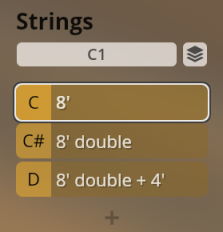
Included Patches
01 Cembalo 8-feet
8' stop
- Velocity Layers: 1
- Release samples
- Alterations: 4
- Samples: 271
02 Cembalo 8-feet double
8' stop, double-stringed
- Velocity Layers: 1
- Release samples
- Alterations: 4
- Samples: 271
03 Cembalo tutti
Tutti: A combination of two 8' stops and one 4' stop
- Velocity Layers: 1
- Release samples
- Alterations: 4
- Samples: 271
02 Harmonium
The Harmonium is a free-reed instrument - air streaming past reeds of different length causes them to vibrate. Contrary to organ pipes, the harmonium's reeds produce more disharmonic overtones, creating a special, undulating sound. The harmonium was used as a substitute for the middle voices in orchestrations, but also as a home instrument and in choral church music when an organ was unavailable. It could even be regarded as a predecessor of the Hammond Organ, as it was sometimes played by eminent jazz musicians like Fats Waller.
Stops:
- Aeoline
- Bassoon-Hautbois
- Clairon-Fifre
- Clarinette-Bourdon
- Flute-Cor anglais
- Voix-Celeste
- Grand jeu
- Percussive
Keyswitches: C7-G7
Range: C1-C6.
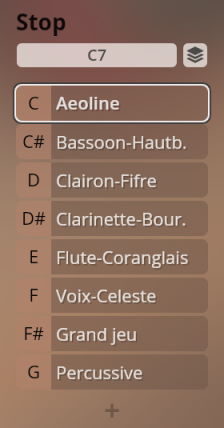
Included Patches
01 Harm Aeoline
Aeoline
- Velocity Layers: 2
- 0-88 mf
- 89-127 f
- Release samples
- Samples: 244
02 Harm Bassoon-Hautbois
Bassoon-Hautbois
- Velocity Layers: 2
- 0-88 mf
- 89-127 f
- Release samples
- Samples: 244
03 Harm Clairon-Fifre
Clairon-Fifre
- Velocity Layers: 2
- 0-88 mf
- 89-127 f
- Release samples
- Samples: 244
04 Harm Clarinette-Bourdon
Clarinette-Bourdon
- Velocity Layers: 2
- 0-88 mf
- 89-127 f
- Release samples
- Samples: 244
05 Harm Flute-Coranglais
Flute-Cor anglais
- Velocity Layers: 2
- 0-88 mf
- 89-127 f
- Release samples
- Samples: 244
06 Harm Grandjeu
Grandjeu
- Velocity Layers: 2
- 0-88 mf
- 89-127 f
- Release samples
- Samples: 244
07 Harm Percussion
Percussive notes
- Velocity Layers: 1
- Release samples
- Alterations: 4
- Samples: 305
08 Harm Voix-Celeste
Voix Celeste
- Velocity Layers: 2
- 0-88 mf
- 89-127 f
- Release samples
- Samples: 244
03 Prepared Piano
The Prepared Piano was made famous by John Cage in 1949, when he first used it to expand the piano's sounds for his compositions. He worked with objects like erasers, nails, wire, paper etc. inserted between a piano's strings of the same pitch in certain places, causing them to produce additional tones, flageolets, or percussive sounds. For our recording sessions, we used a Bosendorfer grand piano, which was also treated bare-handed (e.g., for glissandos over the strings) and with drumsticks in order to get a multitude of creative sounds and colors. While generally keeping to Cage's directions for preparing the piano, thus paying homage to the great innovative composer, we extended all preparations to cover the full range of the piano, so that you can use them in the register which suits your composition.
- Items/Articulations:
- Chain on strings
- Screws between strings
- Harmonics (fingered)
- Aluminium foil
- Waterglass
- Drumstick
- Drumsticks roll
- Glissandi (strings)
Harmonics and rolls have an open/secco option which can be controlled with Dim.Ctrl/A (CC1, modwheel).
- Keyswitches: C0-G0
- Range: F1-E6
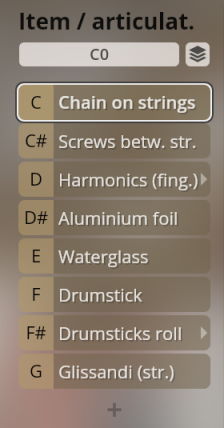
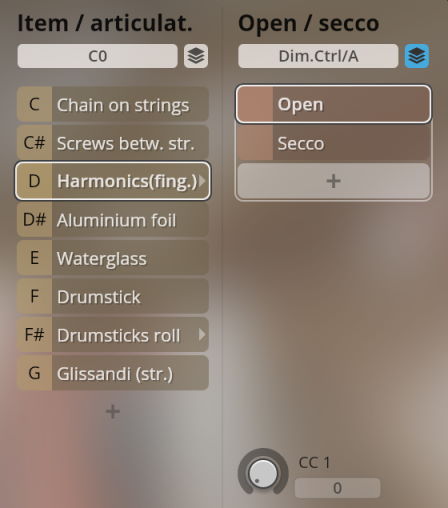
Included Patches
01 PP Chain
Notes are played with a metal chain placed on the strings.
- Velocity Layers: 2
- 0-88 p
- 89-127 f
- Alterations: 2
- Samples: 208
02 PP Double-screw
For this effect, screws are inserted between the strings.
- Velocity Layers: 2
- 0-88 p
- 89-127 f
- Alterations: 2
- Samples: 208
03 PP Harmonic
Harmonics are created damping the string with a finger.
- Velocity Layers: 1
- Alterations: 2
- Samples: 104
04 PP Harmonic secco
Harmonics, secco; here, the finger pressure is so strong that the string is not allowed to vibrate freely.
- Velocity Layers: 2
- 0-88 p;
- 89-127 ff
- Alterations: 2
- Samples: 208
05 PP Foil
Notes are played with aluminum foil put on the strings
- Velocity Layers: 2
- 0-88 p
- 89-127 f
- Alterations: 2
- Samples: 208
06 PP Glas
A waterglass is placed on the strings to create this effect.
- Velocity Layers: 2
- 0-88 p
- 89-127 f
- Alterations: 2
- Samples: 206
07 PP Stick
Played directly on the strings with a drumstick: Single notes Pedal down/up noise at C9/D9
- Velocity Layers: 2
- 0-88 p
- 89-127 f
- Alterations: 2
- Samples: 208
08 PP Stick roll
Played directly on the strings with a drumstick: Rolls
- Velocity Layers: 1
- Release samples
- Samples: 156
08 PP Stick roll secco
Played directly on the strings with a drumstick: Rolls
- Velocity Layers: 1
- Release samples
- Samples: 156
10 PP Glissandi
Glissandi, up and down, var. 1-10. The glissandi are performed directly on the strings, variations go from low range to high range
- Velocity Layers: 2
- 0-88 p
- 89-127 f
- Range: C4-A5
- Samples: 40
- Mapping:
- C4-A4: upward glissandi
- C5-A5: downward glissandi
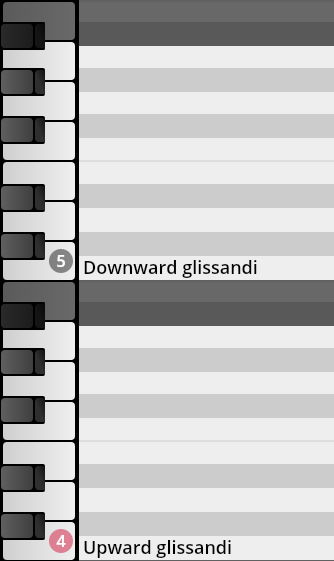
FX Presets
The specially designed FX Presets make use of various combinations of the three Special Keyboards in up to five layers, and effects such as delay, chorus, etc. to create unusual and inspiring sound structures. Here are brief descriptions of these Presets, but of course it is best to listen to them!
01 Progresso
A stable sound to hit some chords.
- CC1: Delay and Chorus lead into distance.
- Layers: 01 Harpsichord 8-feet, 01 Harm Aeoline, 01 PP Chain
- Range: C1-B6.
02 Pacific Island
A plucked sound with a pacific island flair.
- CC1: Switch the volume of Layer 1 and Layer 2 combined with Humanize.
- Layers: 03 PP Harmonic, , 06 Harm Grandjeu, 06 PP Glas
- Range: C1-B6.
03 Dante
An electric (lower) sound.
- CC1: A phase effect combined with a filter.
- Layers: 01 Harm Aeoline, 01 PP Chain, 01 Harpsichord 8-feet
- Range: C1-B6.
04 Roughus
A rough sound to fill your mix.
- CC1: Filter.
- Layers: 06 PP Glas, 07 Harm Voix-Celeste, 05 PP Foil
- Range: C1-B6.
05 Broken String
A rough sound with a blurry release.
- CC1: Autogained Amp.
- Layers: 08 Harm Percussive, 01 Harpsichord 8-feet, 05 PP Foil, 01 PP Chain
- Range: C1-C7.
06 The Creep
Short attack with a modulating sustain.
- CC1: Filter.
- Layers: 09 PP Stick roll secco, 08 PP Stick roll, 05 PP Foil, 01 PP Chain, 03 PP Harmonic
- Range: C1-C7.
07 Repercussion
Deep pulsing bass.
- CC1: Filter.
- Layers: 01 Harpsichord 8-feet (2x), 04 Harm Clarinette-Bourdon
- Range: C1-C3.
08 Instinct
Bass sound with stereo FX.
- CC1: Filter.
- Layers: 05 Harm Flute-Coranglais, 04 Harm Clarinette-Bourdon, 08 PP Stick roll
- Range: C1-C3.
09 Illusion
Nervous evolving pad.
- CC1: Filter.
- Layers: 03 Harm Clairon-Fifre, 03 PP Harmonic, 05 PP Foil
- Range: C1-C5.
10 Disillusion
Resolution to preset nr. 9.
- CC1: Filter.
- Layers: 03 Harm Clairon-Fifre, 02 Harm Bassoon-Hautbois, 06 PP Glas
- Range: C1-C6.
11 Broken Carousel
Creepy sound from an abandoned fun fair.
- CC1: Adds depth.
- Layers: 04 Harm Clarinette-Bourdon, 05 Harm Flute-Coranglais, 03 Harm Clairon-Fifre (2x)
- Range: C1-C6.
12 Glitch Piano
Harsh piano with glitch effects.
- CC1: Lowpass filter.
- Layers: 07 PP Stick, 03 PP Harmonic
- Range: A0-C8.
13 Wave Align
Music box with motor noise.
- CC1: Adds more noise.
- Layers: 03 PP Harmonic, 03 Harm Clairon-Fifre, 09 PP Stick roll secco (2x)
- Range: C1-C6.
14 Stringify
Kind of like an electric guitar.
- CC1: Lowpass filter.
- Layers: 07 PP Stick, 02 Harpsichord 8-feet double, 03 PP Harmonic
- Range: C1-E6.
15 Hades
Piano from the underworld.
- CC1: Lowpass filter.
- Layers: 05 PP Foil, 04 PP Harmonic secco, 02 PP Double-screw
- Range: A0-C8.
16 Roarganic
Recuerdos de la Hammond.
- CC1: Adds reverb.
- Layers: 02 Harpsichord 8-feet double, 01 Harm Aeoline, 03 PP Harmonic
- Range: A0-C7.
17 The Wobble
A toothless piano morphs into hyperspaces.
- CC1: Blend between both.
- Layers: 07 PP Stick (2x), 05 PP Foil
- Range: A0-C8.
18 Toy Story
Mostly a toy piano.
- CC1: Adds some delay.
- Layers: 02 Harpsichord 8-feet double, 01 Harm Aeoline, 03 PP Harmonic
- Range: A0-C6.
19 Ugly Kid Joe
Another broken guitar.
- CC1: Thin or fat.
- Layers: 01 PP Chain
- Range: A0-C8.
20 Hurdy-gurdy
Whether it is broken or untuned -
- CC1: You decide.
- Layers: 06 Harm Grandjeu (3x), 06 PP Glas, 07 PP Stick
- Range: A1-C6.